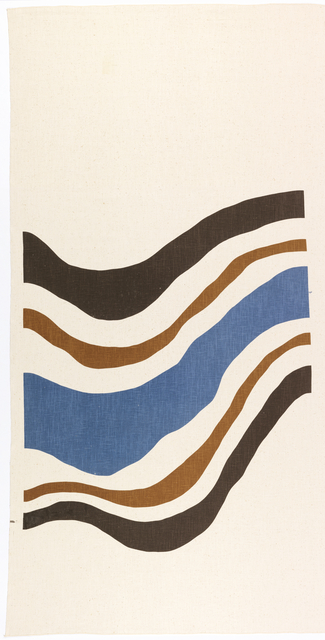Rhythm (1972) is like a visual representation of the movement of sound—the pulsation of music or a heartbeat on an electrocardiogram. In fact, it is the designers’ graphic interpretation of a meandering stream, inspired by the Indiana woodland. This feeling of movement is a product of the design concept promoted by Elenhank Designers, Inc. called the “mural print.” Because the designers engineered the placement of the printed design, the constrictions of standard fabric widths was no longer an issue. By meeting and matching inverted panels, the design could run continuously over a 16-foot-wide span. While Rhythm was also used as a flat wall treatment, Elenhank Designers, Inc. carefully considered how it would perform as a curtain—when gathered, the pattern is foreshortened but the visual flow is not lost. They were mindful that the drapery would not be static, but that it moved well physically and visually.
View work in the collection by Henry and Eleanor Kluck >

Promotional material available to interior designers illustrating how to install Rhythm mural print. Courtesy of Cooper Hewitt study collection, Elenhank design file.
Elenhank Designers, Inc. was founded by the husband and wife duo of architect Henry Kluck and artist Eleanor Kluck from Chicago, with the company name originating as a combination of the designers’ nicknames. The pair began creating textiles in 1946, using linoleum blocks designed by Eleanor to print fabric for their own curtains. They started filling custom orders for clients out of their Chicago home, announcing in a 1948 issue of American Fabrics, “We are concerned with meeting the fabric and design requirements of contemporary architects and interior designers, and with introducing a new vocabulary of fabric expressions.” They incorporated in 1956 and by 1958 moved production to a commercial facility in Riverside, Illinois. The pair transitioned from block printing to experiments with screen printing and continued to design textiles for 33 years. Their designs won many awards, including a Good Design award in 1953 for their Buttony fabric. Cooper Hewitt, along with Metropolitan Museum of Art and Art Institute of Chicago, were offered numerous examples of Elenhank’s designs including both block prints and screen prints.

Rhythm installed as a wallpaper. Courtesy of Cooper Hewitt study collection, Elenhank design file.
